Put your bibs on because there are no plates at The Shrimp Daddy — and things can get pretty messy. The recently opened bayou-style seafood restaurant offers an appealing US Deep South dining experience.
The Shrimp Daddy’s decor is clean and minimal — similar to the rustic vibe of many traditional Taiwanese seafood restaurants. Concrete floors complement white walls, and there is a stack of wooden seafood crates in one corner that will eventually adorn one of them. An oversized chalkboard displays specials along another. The tables are topped with Napkin dispensers and paper tablecloths. You don’t need much more, except an accessible sink, located at the back, since you are encouraged to eat with your hands. Plastic gloves are available if you’re worried about your manicure.
Appetizers, most of which are fried, come delivered in brightly-colored plastic baskets lined with paper. The fish (NT$250), soft-shell crab (NT$290) and fried oysters (NT$290) were particularly memorable because of the different batters, and the dipping sauces that accompanied them: basil, kaffir, and lime aioli, honey wasabi, Sriracha aioli and more. The animal-shaped fries (NT$160) came topped with large portions of caramelized onions, cheese sauce, gravy and big chunks of soft and succulent pork belly. They tasted out of this world.
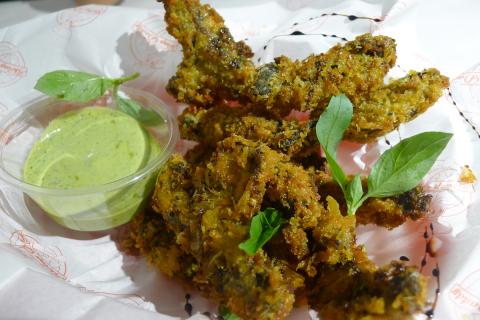
Photo: Olivia Wycech
The gumbo (NT$180) is a must, but if go on a day when lobster bisque (NT$180) is on special, then opt for this rich and creamy soup. There are wings, too, and they come either in a spicy sauce or a miso/honey/togarashi blend and then sprinkled with bonito flakes (NT$230).
The heart of the meal was the southern boil (NT$1380 to NT$7088). We ordered the lobster, which was large, meaty and moist. The waiter arrived with a steaming bag of shellfish and we went to work. It’s a hands-on approach to digging, cracking, peeling and then eating a melange of crustaceans and shellfish, as well as chunks of corn on the cob, sausages and potatoes.
There are other options besides lobster to base your boil on, like Alaskan king crab or Vannamei shrimp. You can also choose your seasoning. We went with the “daddy’s shebang.” It was a little bit buttery, a little bit garlicky, with lots of Cajun zing — big clumps of creole-style herbs were studded throughout. We went easy on the spiciness, so there was almost zero firepower. I wouldn’t hesitate to try the medium or even spicy.
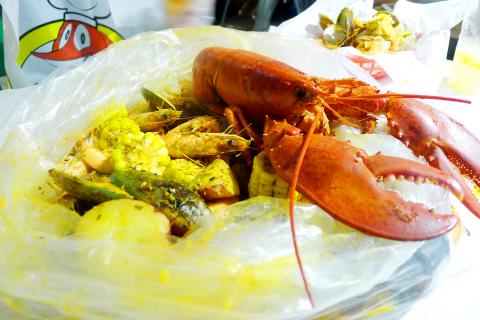
Photo: Olivia Wycech
One small quibble was that it lacked the kind of citrus punch I like, a problem solved with the addition of fresh lemon wedges.
I highly recommend The Shrimp Daddy to anyone except those who might have a corporate meeting afterwards. You leave smelling like the south — and very full. If you still have room, however, there is a limited selection of desserts. The Shrimp Daddy, whose mantra playfully reads Who’s YOUR Daddy, is just as much about the food as it is about the experience, and it wins on both counts.
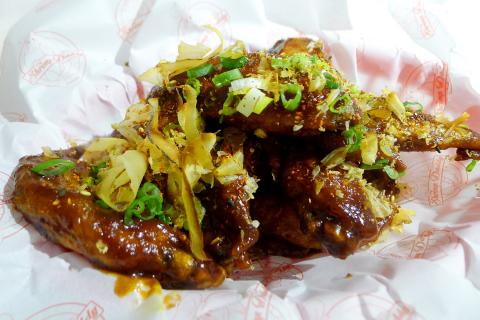
Photo: Olivia Wycech
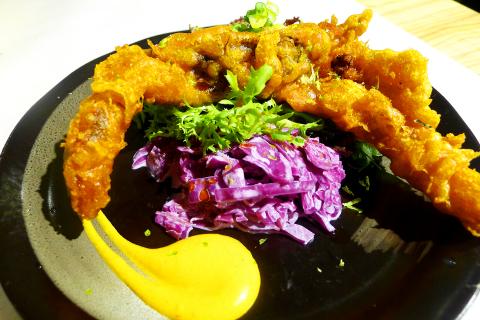
Photo: Olivia Wycech

April 7 to April 13 After spending over two years with the Republic of China (ROC) Army, A-Mei (阿美) boarded a ship in April 1947 bound for Taiwan. But instead of walking on board with his comrades, his roughly 5-tonne body was lifted using a cargo net. He wasn’t the only elephant; A-Lan (阿蘭) and A-Pei (阿沛) were also on board. The trio had been through hell since they’d been captured by the Japanese Army in Myanmar to transport supplies during World War II. The pachyderms were seized by the ROC New 1st Army’s 30th Division in January 1945, serving

The People’s Republic of China (PRC) last week offered us a glimpse of the violence it plans against Taiwan, with two days of blockade drills conducted around the nation and live-fire exercises not far away in the East China Sea. The PRC said it had practiced hitting “simulated targets of key ports and energy facilities.” Taiwan confirmed on Thursday that PRC Coast Guard ships were directed by the its Eastern Theater Command, meaning that they are assumed to be military assets in a confrontation. Because of this, the number of assets available to the PRC navy is far, far bigger

The 1990s were a turbulent time for the Chinese Nationalist Party’s (KMT) patronage factions. For a look at how they formed, check out the March 2 “Deep Dives.” In the boom years of the 1980s and 1990s the factions amassed fortunes from corruption, access to the levers of local government and prime access to property. They also moved into industries like construction and the gravel business, devastating river ecosystems while the governments they controlled looked the other way. By this period, the factions had largely carved out geographical feifdoms in the local jurisdictions the national KMT restrained them to. For example,
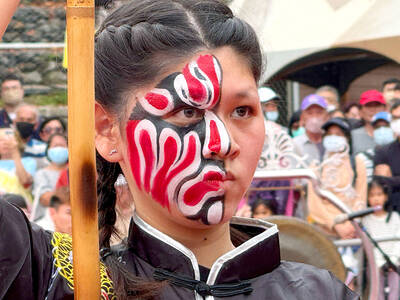
Shunxian Temple (順賢宮) is luxurious. Massive, exquisitely ornamented, in pristine condition and yet varnished by the passing of time. General manager Huang Wen-jeng (黃文正) points to a ceiling in a little anteroom: a splendid painting of a tiger stares at us from above. Wherever you walk, his eyes seem riveted on you. “When you pray or when you tribute money, he is still there, looking at you,” he says. But the tiger isn’t threatening — indeed, it’s there to protect locals. Not that they may need it because Neimen District (內門) in Kaohsiung has a martial tradition dating back centuries. On